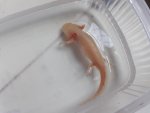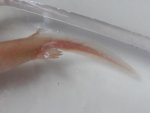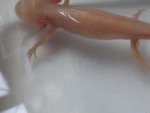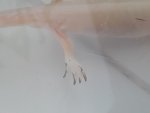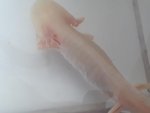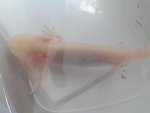Mouse Mason
New member
- Joined
- Mar 18, 2017
- Messages
- 27
- Reaction score
- 0
- Points
- 1
- Country
- England
Hi every one. So I just acquired my third axolotl, a female Albino named Robbie (don't ask). Long story short, I intended to get another male, but when I got to the shop I saw this little girl floating on the top of the tank. She was definitely alive, and kept struggling to get to the bottom but just floated up. The guy in the shop wouldn't sell her at first (in case she died) but I managed to get her in the end (as, whilst I'm no expert, I believe I can look after her better than the shop purely because they have 40+ tanks full of other fish to deal with). So she's at home and seems to be doing better already. She's in her own container with water that i tested and has 0 nitrite and ammonia (it's still the water that was in her tank at the shop, so that's not the issue). The nitrates are high but from testing them I'm pretty certain my test strips are faulty on nitrates. She's only got a bit of water in, so she can touch the bottom and is now much less stressed. She ate a whole cube of blood worms for her dinner, and I let her disgest them for a bit, and now she's in the fridge (I've heard conflicting reports on whether that helps, so any advice welcome). She's not too thin, and very lively. So, other than the floating (and possibly a slight bit of fungus on the tail?) she seems a normal healthy 8 month old axolotl. Is there any cause of the floating that you can think off, and any advice to stop It? Thanks, from both me and Robbie!

